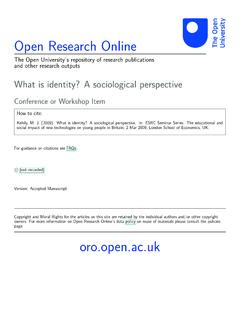Transcription of Open Research Online
1 REVISED VERSION March 93 (Discard previous version) Case Studies of Creativity in Innovative Product Development Robin Roy Design Discipline, Faculty of Technology, The Open University, Milton Keynes MK7 6AA, UK. Keywords: design, product development, creativity, innovations 1 INTRODUCTION Case Studies of creative designers and innovators can reveal much useful understanding and insight into: the product development process; the role of creative thinking in product development, where creative design ideas come from and how they are developed into working products; the problems faced by designers and inventors in getting novel products on to the market as commercial innovations. This paper examines some of these questions through case studies of creative individuals who have invented, designed, developed and introduced innovative products.
2 The individuals and products are: James Dyson, an inventor, entrepreneur and product designer, and his innovative designs of wheelbarrow and vacuum cleaner ; Mark Sanders, a product designer and design consultant, and his novel design of folding In addition brief comparison is made between these cases and similar examples of innovative mechanical products created by other individual inventor/designers. These are cases of designers and innovators either working alone or in a small consultancy business and the focus is on how creative individuals conceive ideas and develop them. Nevertheless, the insights into the creative process provided by these cases are also relevant to the characteristics and practices of designers and engineers working in large R & D and design teams. 2 Research METHOD The case studies were developed using a similar Research method.
3 This first involved background Research on the products and inventor/designers concerned, using published articles, patents, etc., followed by preliminary interviews with the individuals. Then in-depth interviews with the individuals were conducted. Finally, material gathered at the interviews - including promotional material, archive drawings and notes, photographs, etc. - was consulted and a further search for published information was made. The case studies were originally prepared as educational material for an undergraduate Open University design course, entitled Design: Principles and Practice which was first presented in 1992. Video programmes for this course were made using recordings made during the interviews. These videos and the full interview transcripts provided a valuable source of information for the material in this paper. 3 THE CASE STUDIES The case studies presented in this section were chosen to help provide an understanding of the motivations of two creative inventor/designers; their sources of ideas; their different approaches to developing those ideas; their use of drawing and modelling at different stages of product development; their need for specific knowledge and expertise and their use of tools such as creative thinking techniques and computer-aided design (CAD).
4 The cases also illustrate some of the difficulties faced by British inventors and designers in commercialising innovative James Dyson - the Ballbarrow and Cyclone James Dyson is an inventor and designer, trained at the Royal College of Art, who directs a small Research , design and development company based near Bath. He is best known for two products; a wheelbarrow with a ball-shaped wheel called the Ballbarrow and a novel type of domestic cleaner based on the cyclone principle, called the Cyclone or G-force vacuum cleaner . The creative and innovative processes behind the development of these products is outlined below. The Ballbarrow Many innovative designs arise from a creative individual s dissatisfaction with, and desire to improve, existing products - what has been termed constructive discontent . In this case it was Dyson s experience of using of a conventional barrow whose wheel sunk into soft surfaces, whose body shape was poor for mixing cement and which was difficult to tip, that stimulated him to design the Ballbarrow (Figure 1).
5 Dyson got the key idea for a ball-shaped wheel from his experience as a designer in an engineering company called Rotork, where he learned about balloon tyres produced by rotational moulding for amphibious vehicles. This is a clear case of the transfer of an idea and technology from one application to another. From this basic idea, Dyson developed the Ballbarrow concept, from initial sketches and drawings, to a prototype with a fibre-glass wheel moulded around a football, to patents and the finished design. Dyson is an entrepeneur as well as an inventor/designer and always designs with manufacturing constraints and market potential in mind. With a relatively low investment in tooling required, he saw an opportunity to set up a business to make and sell the Ballbarrow. Existing wholesalers and retailers of garden equipment did not think this novel design would sell and so Dyson initially marketed the Ballbarrow by mail order.
6 He discovered that it sold well, even at about three times the price of conventional wheelbarrows. The Ballbarrow was launched in 1975 and after about four years Dyson sold the business to a major manufacturer. The Ballbarrow is still in production over fifteen years after its introduction and is now widely available through Figures 1 and 2 The Cylone vacuum cleaner Dyson s next invention and enterprise arose from a production problem in the Ballbarrow factory. The resin powder used to coat the metal parts of the Ballbarrow kept clogging the fitration system. Dyson was advised to install an industrial cyclone (similar to that used to remove dust from the air in sawmills and other industrial plant) to separate the fine powder from the air. While installing the cyclone James Dyson got the idea for a domestic cleaner that used the cyclone principle to separate the dust from dirty air (see Figure 3).
7 Although it may be argued that the cyclone cleaner idea arose by chance, it is significant that Dyson is always on the lookout for such ideas and chance favours the prepared mind . As with the Ballbarrow, Dyson s cyclone cleaner involved a mental transfer of technology from one application to another - We re never original he observed, there are always connections somewhere . Dyson established the basic technical feasibility of his idea by testing a simple cardboard model cylone fitted to a conventional vacuum cleaner . Dyson then considered the commercial potential of his invention before attempting to develop it. In this case tooling costs were likely to be high and it would therefore be necessary to license production to a major manufacturer. However, since vacuum cleaner technology had been static for years, he considered that the price of a radically new cleaner could be set sufficiently high for it to be a viable proposition.
8 Conceiving the basic idea behind the cyclone cleaner was, however, only the beginning of a lengthy Research , design and development process. Determining the precise shapes of the cyclones needed to efficiently separate coarse particles and fine dust entailed Dyson in making and testing many thousands of brass, aluminium and perspex models in his workshop (Figure 4). He argues that this empirical cut and try approach was necessary because none of the theories about how cyclones worked could provide the answers he wanted. Nevertheless, other individuals might have attempted to model the cyclone mathematically before proceeding to empirical experimenation. The first protoype, with two cyclones, one for particles and one for dust, placed side-by-side was built in 1981 (Figure 4 - centre). This innovative design was an5 upright cleaner that did not clog or lose power as it filled with dust, was easy to empty and had a built-in retractable hose to provide the functions of a cylinder vacuum cleaner .
9 Its design involved Dyson s combination of skills as inventor, engineer and industrial designer. Figures 3, 4 and 5 Dyson showed his prototype cyclone cleaner to the two major UK manufacturers of vacuum cleaners. Although keen to see his invention, these manufacturers were not willing to license it for production. Dyson believes that this rejection was partly due to the not invented here syndrome and partly because such a radically new product represented too great a risk and challenge to the established technology. Undeterred, Dyson conducted further design and development work and produced a completely new design with concentric cyclones plus other improved features (the G-force vacuum cleaner - see Figure 3 and Figure 4 -left). He deliberately designed the product to be coloured pink to emphasis its innovativeness and made the cylone enclosure transparent so that customers would be be to observe the swirling dust particles.
10 From a market standpoint , Dyson argues, if the product contains any new ideas then it is absolutely essential that the product be visually different . 1 This design was successfully licensed in 1986 to a Japanese manufacturer after an abortive contract involving a British, an Italian and a US firm. The US firm subsequently copied the cyclone cleaner , which forced Dyson into very costly patent litigation. In the early 1990s the pink vacuum cleaner continued in production in Japan in limited numbers for design-conscious customers willing to pay 1100 for the machine. However, by then Dyson had licenced another US firm to produce a cyclone cleaner called the Fantom which was coloured black and sold at a more realistic price of about $300. In 1993 Dyson s company launched in the UK another new design of cyclone cleaner , the Dyson Dual Cyclone (Figure 5).




